clock RENAULT MEGANE HATCHBACK 2015 X95 / 3.G Owners Manual
[x] Cancel search | Manufacturer: RENAULT, Model Year: 2015, Model line: MEGANE HATCHBACK, Model: RENAULT MEGANE HATCHBACK 2015 X95 / 3.GPages: 268, PDF Size: 5.01 MB
Page 7 of 268
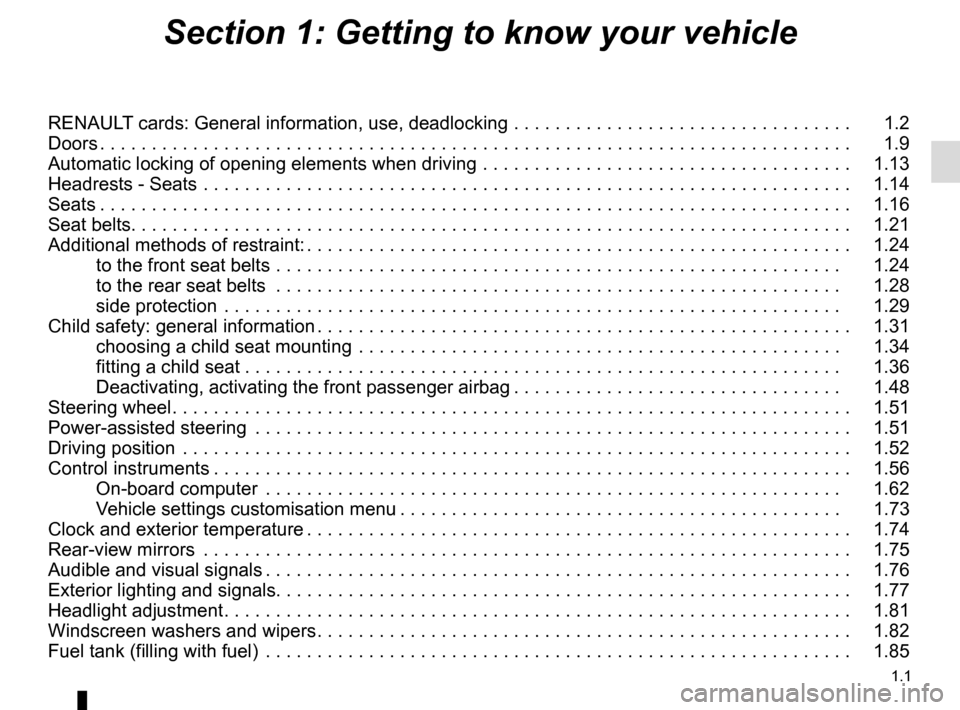
1.1
Section 1: Getting to know your vehicle
RENAULT cards: General information, use, deadlocking . . . . . . . . . . . . . . . . . . . . . . . . . . . . . . . . . 1.2
Doors . . . . . . . . . . . . . . . . . . . . . . . . . . . . . . . . . . . . \
. . . . . . . . . . . . . . . . . . . . . . . . . . . . . . . . . . . . . 1.9
Automatic locking of opening elements when driving . . . . . . . . . . . . . . . . . . . . . . . . . . . . . . . . . . . .\
1.13
Headrests - Seats . . . . . . . . . . . . . . . . . . . . . . . . . . . . . . . . . . . .\
. . . . . . . . . . . . . . . . . . . . . . . . . . . 1.14
Seats . . . . . . . . . . . . . . . . . . . . . . . . . . . . . . . . . . . . \
. . . . . . . . . . . . . . . . . . . . . . . . . . . . . . . . . . . . . 1.16
Seat belts. . . . . . . . . . . . . . . . . . . . . . . . . . . . . . . \
. . . . . . . . . . . . . . . . . . . . . . . . . . . . . . . . . . . . . . . 1.21
Additional methods of restraint: . . . . . . . . . . . . . . . . . . . . . . . . . . . . . . . . . . . . \
. . . . . . . . . . . . . . . . . 1.24to the front seat belts . . . . . . . . . . . . . . . . . . . . . . . . . . . . . . . . . . . .\
. . . . . . . . . . . . . . . . . . . 1.24
to the rear seat belts . . . . . . . . . . . . . . . . . . . . . . . . . . . . . . . . . . . .\
. . . . . . . . . . . . . . . . . . . 1.28
side protection . . . . . . . . . . . . . . . . . . . . . . . . . . . . . . . . . . . .\
. . . . . . . . . . . . . . . . . . . . . . . . 1.29
Child safety: general information . . . . . . . . . . . . . . . . . . . . . . . . . . . . . . . . . . . . \
. . . . . . . . . . . . . . . . 1.31 choosing a child seat mounting . . . . . . . . . . . . . . . . . . . . . . . . . . . . . . . . . . . .\
. . . . . . . . . . . 1.34
fitting a child seat . . . . . . . . . . . . . . . . . . . . . . . . . . . . . . . . . . . . \
. . . . . . . . . . . . . . . . . . . . . . 1.36
Deactivating, activating the front passenger airbag . . . . . . . . . . . . . . . . . . . . . . . . . . . . . . . . 1.48
Steering wheel . . . . . . . . . . . . . . . . . . . . . . . . . . . . . . . . . . . . \
. . . . . . . . . . . . . . . . . . . . . . . . . . . . . . 1.51
Power-assisted steering . . . . . . . . . . . . . . . . . . . . . . . . . . . . . . . . . . . .\
. . . . . . . . . . . . . . . . . . . . . . 1.51
Driving position . . . . . . . . . . . . . . . . . . . . . . . . . . . . . . . . . . . .\
. . . . . . . . . . . . . . . . . . . . . . . . . . . . . 1.52
Control instruments . . . . . . . . . . . . . . . . . . . . . . . . . . . . . . . . . . . . \
. . . . . . . . . . . . . . . . . . . . . . . . . . 1.56 On-board computer . . . . . . . . . . . . . . . . . . . . . . . . . . . . . . . . . . . .\
. . . . . . . . . . . . . . . . . . . . 1.62
Vehicle settings customisation menu . . . . . . . . . . . . . . . . . . . . . . . . . . . . . . . . . . . . \
. . . . . . . 1.73
Clock and exterior temperature . . . . . . . . . . . . . . . . . . . . . . . . . . . . . . . . . . . . \
. . . . . . . . . . . . . . . . . 1.74
Rear-view mirrors . . . . . . . . . . . . . . . . . . . . . . . . . . . . . . . . . . . .\
. . . . . . . . . . . . . . . . . . . . . . . . . . . 1.75
Audible and visual signals . . . . . . . . . . . . . . . . . . . . . . . . . . . . . . . . . . . . \
. . . . . . . . . . . . . . . . . . . . . 1.76
Exterior lighting and signals. . . . . . . . . . . . . . . . . . . . . .\
. . . . . . . . . . . . . . . . . . . . . . . . . . . . . . . . . . 1.77
Headlight adjustment . . . . . . . . . . . . . . . . . . . . . . . . . . . . . . . . . . . . \
. . . . . . . . . . . . . . . . . . . . . . . . . 1.81
Windscreen washers and wipers . . . . . . . . . . . . . . . . . . . . . . . . . . . . . . . . . . . . \
. . . . . . . . . . . . . . . . 1.82
Fuel tank (filling with fuel) . . . . . . . . . . . . . . . . . . . . . . . . . . . . . . . . . . . .\
. . . . . . . . . . . . . . . . . . . . . 1.85
Page 33 of 268
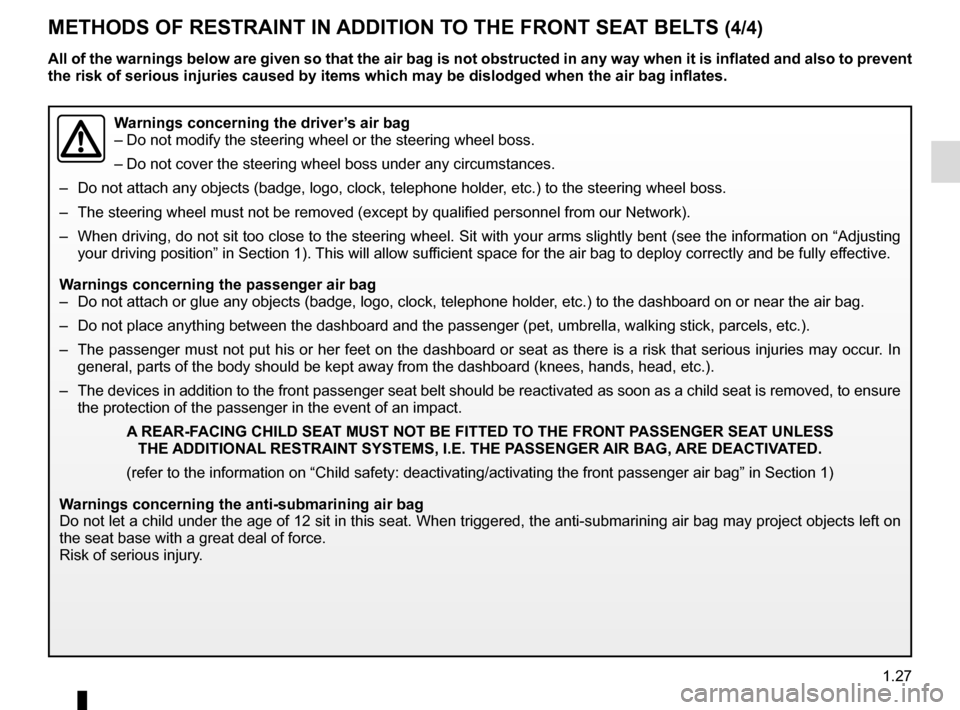
1.27
METHODS OF RESTRAINT IN ADDITION TO THE FRONT SEAT BELTS (4/4)
Warnings concerning the driver’s air bag
– Do not modify the steering wheel or the steering wheel boss.
– Do not cover the steering wheel boss under any circumstances.
– Do not attach any objects (badge, logo, clock, telephone holder, etc.) to the steering wheel boss.
– The steering wheel must not be removed (except by qualified personnel f\
rom our Network).
– When driving, do not sit too close to the steering wheel. Sit with your \
arms slightly bent (see the information on “Adjusting
your driving position” in Section 1). This will allow sufficient space for the air bag to deploy correctly and be fully effective.
Warnings concerning the passenger air bag
– Do not attach or glue any objects (badge, logo, clock, telephone holder\
, etc.) to the dashboard on or near the air bag.
– Do not place anything between the dashboard and the passenger (pet, umb\
rella, walking stick, parcels, etc.).
– The passenger must not put his or her feet on the dashboard or seat as t\
here is a risk that serious injuries may occur. In general, parts of the body should be kept away from the dashboard (knee\
s, hands, head, etc.).
– The devices in addition to the front passenger seat belt should be react\
ivated as soon as a child seat is removed, to ensure the protection of the passenger in the event of an impact.
A REAR-FACING CHILD SEAT MUST NOT BE FITTED TO THE FRONT PASSENGER SEAT UNLESS THE ADDITIONAL RESTRAINT SYSTEMS, I.E. THE PASSENGER AIR BAG, ARE DEACTIVATED.
(refer to the information on “Child safety: deactivating/activating \
the front passenger air bag” in Section 1)
Warnings concerning the anti-submarining air bag
Do not let a child under the age of 12 sit in this seat. When triggered,\
the anti-submarining air bag may project objects left on
the seat base with a great deal of force.
Risk of serious injury.
All of the warnings below are given so that the air bag is not obstructe\
d in any way when it is inflated and also to prevent
the risk of serious injuries caused by items which may be dislodged when\
the air bag inflates.
Page 80 of 268
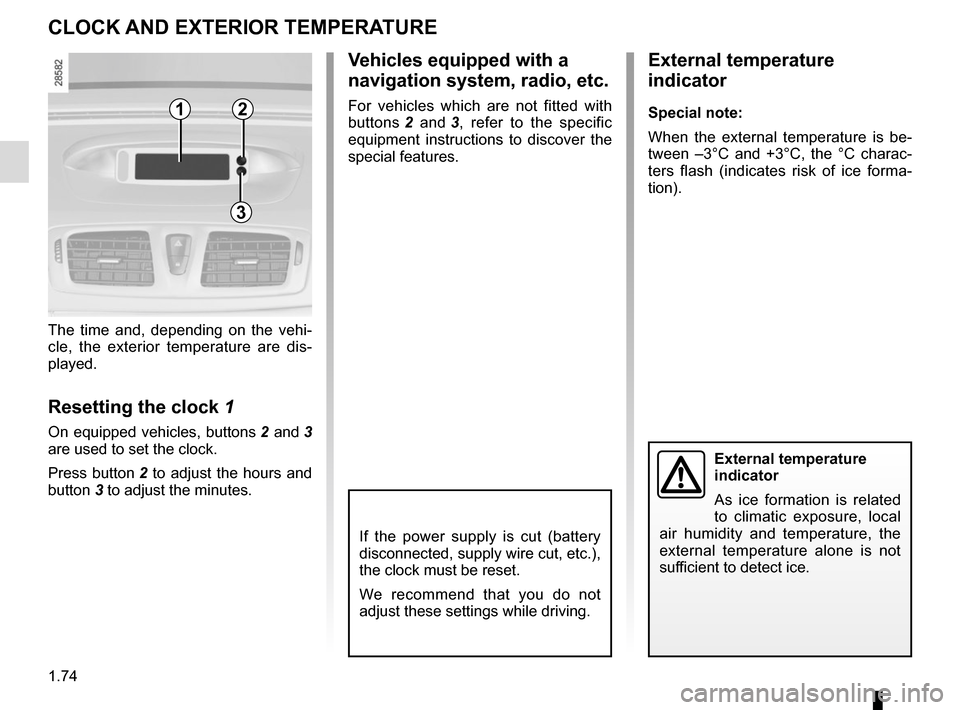
1.74
The time and, depending on the vehi-
cle, the exterior temperature are dis-
played.
Resetting the clock 1
On equipped vehicles, buttons 2 and 3
are used to set the clock.
Press button 2 to adjust the hours and
button 3 to adjust the minutes.
External temperature
indicator
As ice formation is related
to climatic exposure, local
air humidity and temperature, the
external temperature alone is not
sufficient to detect ice.
CLOCK AND EXTERIOR TEMPERATURE
External temperature
indicator
Special note:
When the external temperature is be-
tween –3°C and +3°C, the °C charac-
ters flash (indicates risk of ice forma-
tion).
Vehicles equipped with a
navigation system, radio, etc.
For vehicles which are not fitted with
buttons 2 and 3, refer to the specific
equipment instructions to discover the
special features.12
3
If the power supply is cut (battery
disconnected, supply wire cut, etc.),
the clock must be reset.
We recommend that you do not
adjust these settings while driving.
Page 145 of 268
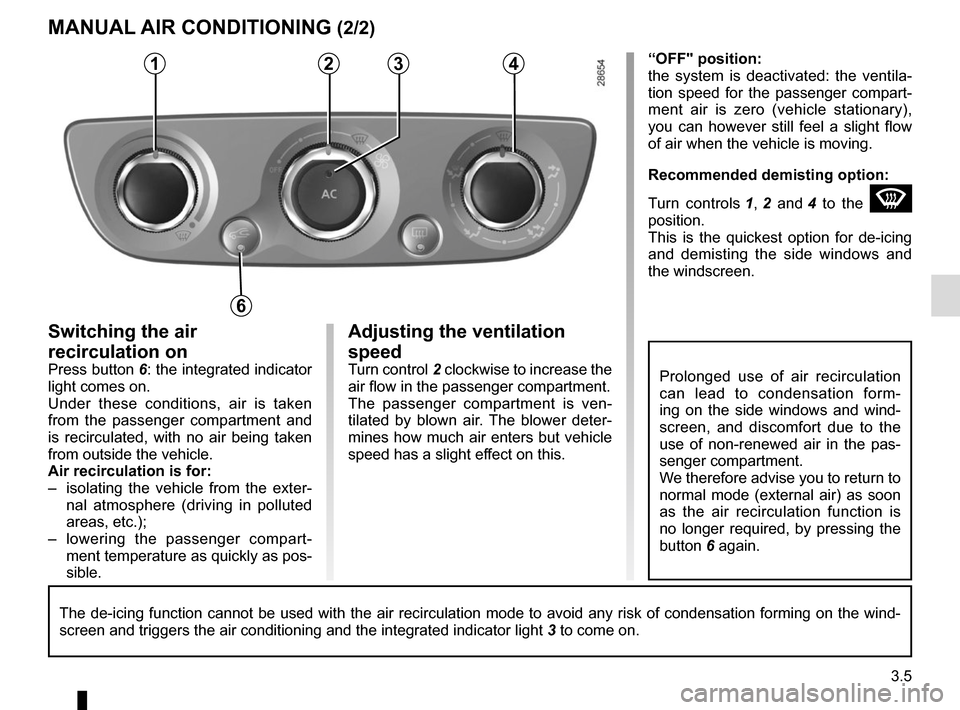
3.5
Adjusting the ventilation
speed
Turn control 2 clockwise to increase the
air flow in the passenger compartment.
The passenger compartment is ven-
tilated by blown air. The blower deter-
mines how much air enters but vehicle
speed has a slight effect on this.
Switching the air
recirculation on
Press button 6: the integrated indicator
light comes on.
Under these conditions, air is taken
from the passenger compartment and
is recirculated, with no air being taken
from outside the vehicle.
Air recirculation is for:
– isolating the vehicle from the exter- nal atmosphere (driving in polluted
areas, etc.);
– lowering the passenger compart- ment temperature as quickly as pos-
sible. “OFF" position:
the system is deactivated: the ventila-
tion speed for the passenger compart-
ment air is zero (vehicle stationary),
you can however still feel a slight flow
of air when the vehicle is moving.
Recommended demisting option:
Turn controls
1, 2 and 4 to the
W
position.
This is the quickest option for de-icing
and demisting the side windows and
the windscreen.
MANUAL AIR CONDITIONING (2/2)
Prolonged use of air recirculation
can lead to condensation form-
ing on the side windows and wind-
screen, and discomfort due to the
use of non-renewed air in the pas-
senger compartment.
We therefore advise you to return to
normal mode (external air) as soon
as the air recirculation function is
no longer required, by pressing the
button 6 again.
The de-icing function cannot be used with the air recirculation mode to \
avoid any risk of condensation forming on the wind-
screen and triggers the air conditioning and the integrated indicator li\
ght 3 to come on.
1234
6
Page 194 of 268
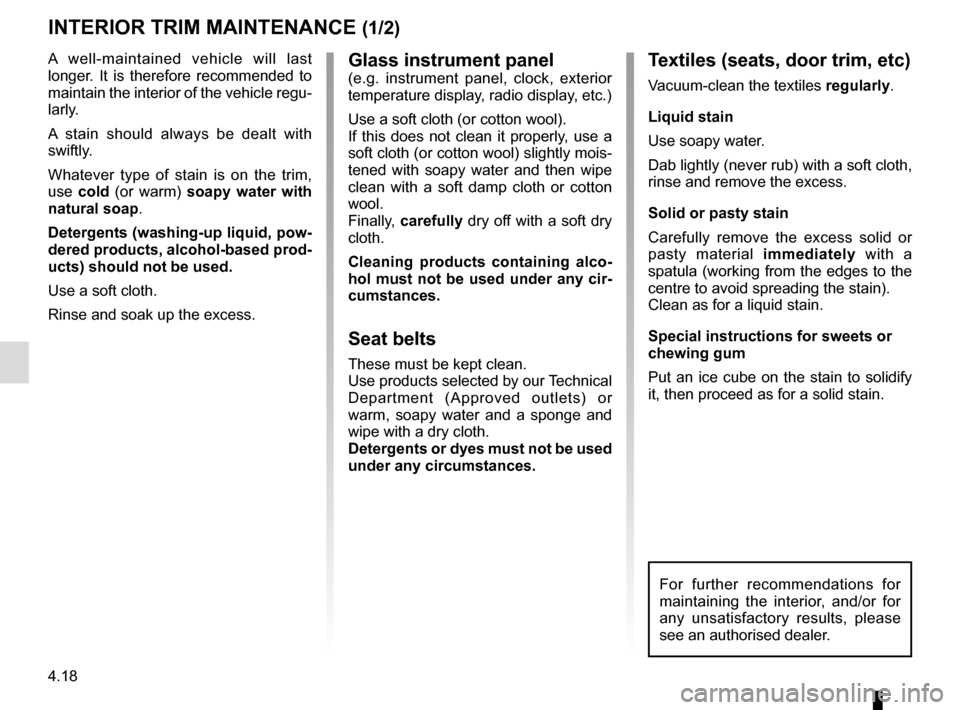
4.18
Glass instrument panel(e.g. instrument panel, clock, exterior
temperature display, radio display, etc.)
Use a soft cloth (or cotton wool).
If this does not clean it properly, use a
soft cloth (or cotton wool) slightly mois-
tened with soapy water and then wipe
clean with a soft damp cloth or cotton
wool.
Finally, carefully dry off with a soft dry
cloth.
Cleaning products containing alco-
hol must not be used under any cir-
cumstances.
Seat belts
These must be kept clean.
Use products selected by our Technical
Department (Approved outlets) or
warm, soapy water and a sponge and
wipe with a dry cloth.
Detergents or dyes must not be used
under any circumstances.
INTERIOR TRIM MAINTENANCE (1/2)
Textiles (seats, door trim, etc)
Vacuum-clean the textiles regularly.
Liquid stain
Use soapy water.
Dab lightly (never rub) with a soft cloth,
rinse and remove the excess.
Solid or pasty stain
Carefully remove the excess solid or
pasty material immediately with a
spatula (working from the edges to the
centre to avoid spreading the stain).
Clean as for a liquid stain.
Special instructions for sweets or
chewing gum
Put an ice cube on the stain to solidify
it, then proceed as for a solid stain.
A well-maintained vehicle will last
longer. It is therefore recommended to
maintain the interior of the vehicle regu-
larly.
A stain should always be dealt with
swiftly.
Whatever type of stain is on the trim,
use
cold (or warm) soapy water with
natural soap.
Detergents (washing-up liquid, pow-
dered products, alcohol-based prod-
ucts) should not be used.
Use a soft cloth.
Rinse and soak up the excess.
For further recommendations for
maintaining the interior, and/or for
any unsatisfactory results, please
see an authorised dealer.
Page 261 of 268
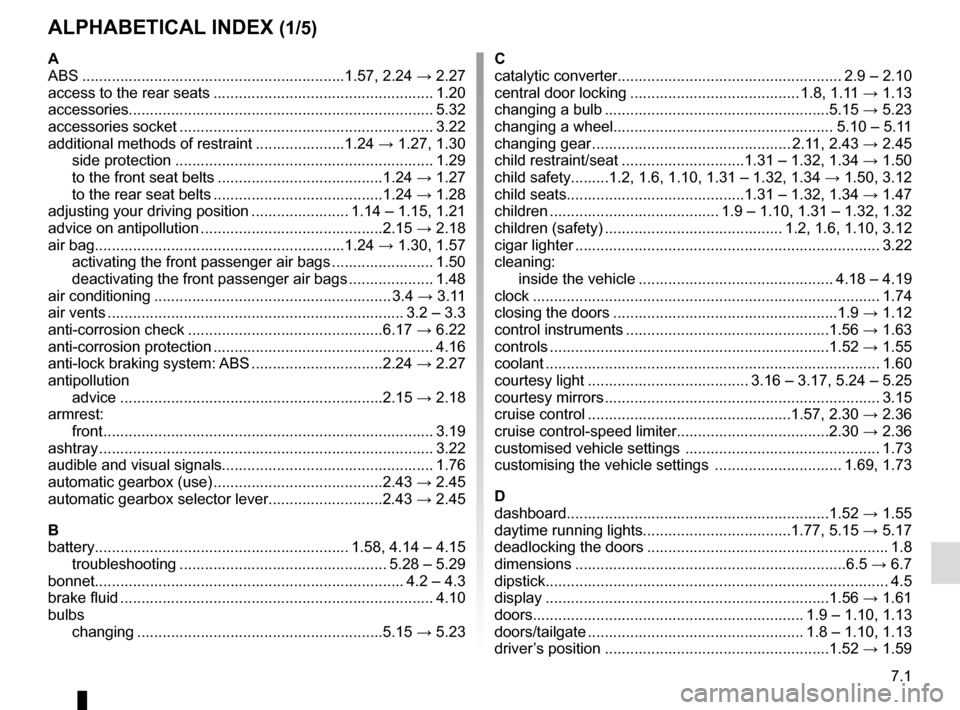
7.1
ALPHABETICAL INDEX (1/5)
A
ABS ..............................................................1.57, \
2.24 → 2.27
access to the rear seats .................................................... 1.20
accessories.............................................................\
........... 5.32
accessories socket ............................................................ 3.22
additional methods of restraint .....................1.24 → 1.27, 1.30
side protection ............................................................. 1.29
to the front seat belts .......................................1.24 → 1.27
to the rear seat belts ........................................1.24 → 1.28
adjusting your driving position ....................... 1.14 – 1.15, 1.21
advice on antipollution ...........................................2.15 → 2.18
air bag...........................................................1.24 → 1.30, 1.57
activating the front passenger air bags ........................ 1.50
deactivating the front passenger air bags .................... 1.48
air conditioning ........................................................ 3.4 → 3.11
air vents ...................................................................... 3.2 – 3.3
anti-corrosion check ..............................................6.17 → 6.22
anti-corrosion protection .................................................... 4.16
anti-lock braking system: ABS ...............................2.24 → 2.27
antipollution advice ..............................................................2.1\
5 → 2.18
armrest: front ..................................................................\
............ 3.19
ashtray ................................................................\
............... 3.22
audible and visual signals.................................................. 1.76
automatic gearbox (use) ........................................2.43 → 2.45
automatic gearbox selector lever...........................2.43 → 2.45
B
battery............................................................ 1.58, 4.14 – 4.15 troubleshooting ................................................. 5.28 – 5.29
bonnet..................................................................\
....... 4.2 – 4.3
brake fluid ........................................................................\
.. 4.10
bulbs changing ..........................................................5.15 \
→ 5.23C
catalytic converter.....................................................\
2.9 – 2.10
central door locking ........................................ 1.8, 1.11
→ 1.13
changing a bulb .....................................................5.15 → 5.23
changing a wheel.................................................... 5.10 – 5.11
changing gear ............................................... 2.11, 2.43 → 2.45
child restraint/seat .............................1.31 – 1.32, 1.34 → 1.50
child safety.........1.2, 1.6, 1.10, 1.31 – 1.32, 1.34 → 1.50, 3.12
child seats..........................................1.31 – 1.32, 1.3\
4 → 1.47
children ........................................ 1.9 – 1.10, 1.31 – 1.32, 1.32
children (safety) .......................................... 1.2, 1.6, 1.10, 3.12
cigar lighter ........................................................................\
3.22
cleaning: inside the vehicle .............................................. 4.18 – 4.19
clock ..................................................................\
................ 1.74
closing the doors .....................................................1.9 → 1.12
control instruments ................................................1.56 → 1.63
controls ...............................................................\
...1.52 → 1.55
coolant ................................................................\
............... 1.60
courtesy light ...................................... 3.16 – 3.17, 5.24 – 5.25
courtesy mirrors ................................................................. 3.15
cruise control ................................................1.57, 2.30 → 2.36
cruise control-speed limiter....................................2.30 → 2.36
customised vehicle settings .............................................. 1.73
customising the vehicle settings .............................. 1.69, 1.73
D
dashboard..............................................................1\
.52 → 1.55
daytime running lights...................................1.77, 5.15 → 5.17
deadlocking the doors ......................................................... 1.8
dimensions .............................................................\
...6.5 → 6.7
dipstick................................................................\
................. 4.5
display ................................................................\
...1.56 → 1.61
doors................................................................ 1.9 – 1.10, 1.13
doors/tailgate ................................................... 1.8 – 1.10, 1.13
driver’s position .....................................................1.52 →
1.59